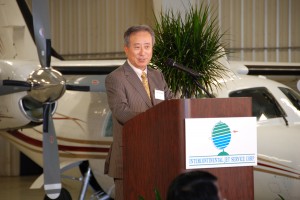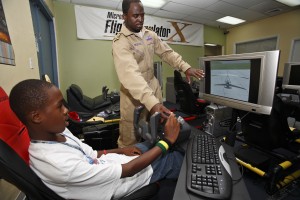
Noel Takayama, general manager of Mitsubishi Heavy Industries America Inc., highlighted the company’s continuing commitment to the MU-2 as well as imminent aircraft such as the Mitsubishi Regional Jet.
By Clayton Moore
Mitsubishi Heavy Industries America Inc. reopened its flagship service center in Tulsa, Okla., on June 20 with a generous celebration that drew aviation celebrities, governmental representatives and other luminaries. The event focused on aviation education, as industry leaders promised to work towards providing opportunities for young people interested in pursuing careers in aviation.
The open house, held at the company’s recently reopened Intercontinental Jet Service Corporation at Tulsa International Airport (TUL), attracted more than 150 guests to a reception at the IJSC hangar, including representatives for Sen. Jim Inhofe and Congressman John Sullivan of Oklahoma; Mike Bunney, the chief economic development officer for the city of Tulsa; Eiichi Ishii, president and CEO of MHIA; and Noel Takayama, general manager of MHIA’s product support division for its flagship aircraft, the MU-2.
The 45,000-square-foot IJSC aircraft service facility employs 36 people and is the largest of six support centers for the MU-2. MHIA acquired the facility in 2006 and has renewed and expanded the facility through nearly two years of construction. Another six acres of undeveloped land gives the service center room to grow in the future.
Mitsubishi and the MU-2 have a long history in the region. Mitsubishi first manufactured the aircraft in San Angelo, Texas, and has operated out of Tulsa for more than 40 years, while MHIA maintains its own headquarters in Dallas. Company leaders acknowledged both the aircraft’s past and promising future during the day’s speeches.

L to R: Intercontinental Jet Service President Dennis Braner, Mitsubishi Heavy Industries Dep. GM Hirokazu Yorimasa, Turbine Aircraft Services President Tom Berscheidt, Barrington Irving, Heavy Industries America GM Noel Takayama and CEO Eiishi Ishii.
“MHIA has had a long and famous commitment to aviation, especially in Oklahoma and the Southwest,” Takayama said. “Now that the construction is done, we decided that the new IJSC should be introduced to the local community so we can acknowledge our relationships with local government and the local communities. Of course, we expect more customers to recognize us as well and boost our business. We consider the IJSC one of the birthplaces of the MU-2, so it’s very appropriate to have an open house to celebrate the completion of the construction.”
Although the MU-2’s reputation suffered some impairment in the past decade due to a series of crashes, MHIA has a good reason for newfound optimism. In March, the FAA released a special rule, SFAR 108, which makes MU-2 training mandatory for all pilots who want to fly the airplane. MHIA has been calling for more restrictive training requirements for some time, but the FAA rulings marks only the second time that the governmental body has issued a training-specific regulation for type-specific pilot training in aircraft that don’t require a type rating.
“The future of the MU-2 program is very positive,” said Scott Sobel, a media consultant who helps craft MHIA’s messages to its aviation community. “The MU-2 owners and operators now know what to expect. Now that the FAA has supported the training guidelines for the MU-2, the environment has changed. Owners and operators are being very positive and proactive about their aircraft and sales have gone up, which is a good indicator of the confidence that owners and operators have in the MU-2 and the new SFAR.”

Katheryn Pennington, executive director of the Tulsa Air & Space Museum, accepted a check for $5,000 from Dennis Braner of Intercontinental Jet Service Center and Mitsubishi Heavy Industries America executives Noel Takayama and Eiichi Ishii.
Takayama said he believes that the training mandated by the FAA is critical not only to the continuing success of the MU-2 but all aircraft.
“Mitsubishi is very proactive about safety in aviation, not only for our own products but for all aircraft,” he said. “Training is key for the safety of any product in aviation. I hope that the FAA, looking forward to promoting safety in the future, considers a reinforcement program for all aviation products. There are many different areas in which I believe they can take action to improve the safety of the entire aviation world.”
At the Tulsa event, the company also showcased the new MU-2 Limited Edition, an enhanced version of the workhorse aircraft that includes Honeywell TPE331-10 engines, a fresh propeller overhaul by Hartzell Propeller Inc., pilot training by SimCom Training Centers and other functional and aesthetic upgrades.
An educational mission
Like nearly all other aviation-based companies, MHIA believes encouraging more young people to become involved and work in the industry is good for everybody. Ann afternoon visit to the nearby Tulsa Air & Space Museum boosted the event’s educational goals; MHIA presented the institution with a $5,000 check to benefit its educational programs.

During the open house, Mitsubishi showed off its new MU-2 Limited Edition, an enhanced version of the workhorse aircraft that features upgraded engines and lavish aesthetic improvements.
MHIA also arranged a visit from aviation record holder Barrington Irving, who talked with area students about his inspiring 2007 flight. The young pilot has become an inspiration to all, including many urban and rural students who followed his accomplishments as the first black pilot and youngest person ever to fly solo around the world. He has since enhanced his own mission through the development of Experience Aviation Inc., a nonprofit educational organization that develops hands-on educational programs, career guidance and mentorship to secondary school students.
While the event also allowed MHIA to reintroduce itself to a business and aviation community in which it’s heavily invested, the reception put its focus on the need to introduce young people to the field of aviation, not only to heighten their own opportunities but also to support an industry in dire need of a future workforce.
“It’s important for young people to get involved in the aviation and aerospace industry, simply because the workforce is aging and it’s such a vital part of our economy,” Irving said. “There are tons of careers to be had. This workplace is getting old and they need young people.”
Irving’s latest endeavor, called Build & Soar, is a joint construction project that Experience Aviation and Miami Dade County Public Schools will carry out. This summer, school districts across the nation will follow a related curriculum as 60 inner-city high school students work with Irving and other aviation professionals to construct a flyable, two-seat aircraft from scrap metal.

Barrington Irving, the youngest pilot to fly solo around the globe, revisited his historic flight with children from Tulsa-area schools at the Tulsa Air & Space Museum.
MHIA is also providing financial support to Experience Aviation after becoming acquainted with Irving at an event last year at the Wings Over the Rockies Air & Space Museum.
“We’re both looking at a common goal,” Takayama said. “We know that he’s doing his part to provide the educational programming that youth need. It has been my experience that young people today are going right into the information technology market without ever touching the hardware involved in fields like aviation maintenance. There’s a lot of computer software involved in a cockpit, but the remaining 90 percent of the hardware components in any given aircraft have to be maintained by people in a hands-on fashion. Hopefully in the future, we’ll be able to do something even more closely together to support opportunities for youth in aviation.”
The gift to the Tulsa museum is the most recent gesture in a series of partnerships MHIA has developed with educational and public service programs around the country. During the event in October 2007 at Denver’s Wings Over the Rockies, the company donated $25,000 to the institution for youth education programs, and later delivered to the museum an MU-2 fuselage for use in hands-on educational programs.

Eiichi Ishii, president and CEO of Mitsubishi Heavy Industries America Inc., declared the company’s commitment to providing opportunities for young people wishing to pursue careers in the aviation industry.
Other recipients of the company’s support include Grace on Wings, a nonprofit organization that provides cost-effective air transportation for individuals in need of critical medical treatments, and more recently, the Smithsonian’s Steven F. Udvar-Hazy Center.
The air museum, which is based at Washington Dulles International Airport (IAD), recently played host to a reception for 300 guests following one of MHIA’s Pilot’s Review of Proficiency programs, an educational seminar oriented towards pilots of the MU-2. The programs, designed to increase the proficiency and experience of MU-2 and other aircraft owners, are free to all attendees.
“Our PROP program has been in existence since 1994, and this year has been one of our most successful programs,” Takayama said. “Mitsubishi is committed to looking for any opportunities to improve our safety program. PROP is the only program of its kind in the United States, and is extraordinary when you consider that the MU-2 is no longer in production. One thing everybody agreed on this year was that the event we had inside the Udvar-Hazy Center exceeded all expectations. Everybody who attended was excited to experience the aviation history there.”
MHIA’s mission to provide future roles for youth in the aviation and aerospace industries is far more than simple generosity, according to Takayama. The company will need smart young engineers and maintenance personnel for many years not only to service the MU-2, but also to support customers of Mitsubishi’s newest aircraft, the Mitsubishi Regional Jet, a 70-90 passenger aircraft poised to make its debut this year. MHIA anticipates demand for about 5,000 aircraft of the MRJ’s class in the global regional jet market over the next 20 years.

At his own Experience Aviation facility at Miami International Airport, Barrington Irving helps a student get his wings on a state-of-the-art flight simulator.
“I believe that our efforts to get young people into the aviation business is important to support not only our newest airplane program, but also the many older airframes that we support as well as the customers still using those airframes,” Takayama said. “Without the young people coming up from educational programs like Mr. Irving’s, we believe there would be no future in the aviation business.”
For more information about Mitsubishi Heavy Industries America Inc., visit [http://www.mitsubishitoday.com].











